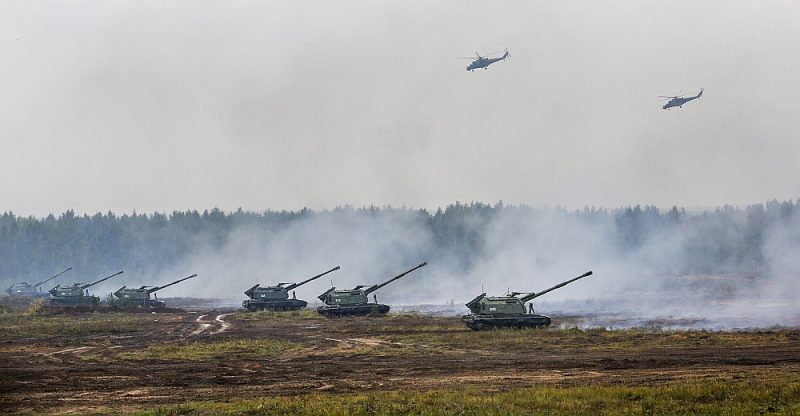
Russian and Belarusian armed forces are training at the Zapad training ground in Borisovskaya, Belarus, in September 2017.
Photo: Sergei Grits / AP / SCANPIX / LETA
Ģederts Ģelzis, “Latvijas Avīze”, JSC “Latvijas Mediji”
Next month, the Russian and Belarusian military landfills will receive close attention not only from the Baltic States, but also internationally. Both neighboring countries of Latvia will hold extensive and ambitious military exercises “Zapad 2021” (translated from Russian – “Western”), the active phase of which will take place from 10 to 16 September.
–
The news
“A drama is beginning to play out where the covid is just the background.” A sociologist on a deep problem
14 hours
–
The news
“Coming soon there will be new restrictions! ” Pavluts talks about the consequences of the covid outbreak
4 hours
–
Cocktail
PHOTO. Aldis Gobzems publishes a photo with his children and calls them “smurfs”
7 hours
–
The Russian and Belarusian state media report that the exercises will take place in four military landfills on the territory of Belarus and in nine landfills in Russia, which are located near the borders of the Baltic States. According to the Kremlin-controlled news agency TASS, 12,800 people will take part in the exercise in Belarus, including about 2,500 military personnel from Russia and 50 from Kazakhstan, while about 400 Belarusian soldiers will be training on Russian territory. The training maneuvers will use several hundred units of the armed forces, including 140 tanks and more than 30 planes and helicopters.
The first echelons with parts of the Russian army started arriving in Belarus at the end of June and are currently continuing. The joint strategic exercise is “defense-oriented” and will “reaffirm Belarus’s commitment to strengthening regional security and its commitment to its ally, the Russian Federation,” said Viktor Gulevich, Belarus’s first deputy defense minister.
Grinds the capture of the Baltic States
The Russian armed forces have five large war zones, and a great variety of military exercises take place every year. “This is not unusual,” says Jānis Bērziņš, director of the Security and Strategic Research Center at the Latvian National Defense Academy, in a conversation with Latvijas Avīze, who adds that Latvia also trains its soldiers together with NATO allies.
“For example, only (Russia’s) plan with Belarus does not mean that they are implementing all, more than 200 exercises were planned this year.” They are much smaller than the Zapad, which takes place every four years in Russia’s Western War area. They are ambitious and historically intended to train for a possible conflict with NATO.
“I don’t think Zapad aims to seize the Baltic states.” [..] We all automatically assume that Russia wants to attack us, occupy us so that we are part of the Russian Empire again, ”says Bērziņš. According to him, Russia has other problems that are more important and urgent with the conflict with NATO, which would be extremely costly.
“The only thing that saves us is Ukraine,” an official in the national defense sector told Latvijas Avīze, who constantly monitors the military activities of Russia and Belarus and agreed to reveal Zapad’s potential level of threat to Latvia, but with the agreement that we would not disclose word, not position. “However, Ukraine is more important in their whole range of values. [..] The fact that Ukraine is democratic is terrible for the Russian regime! [..] If Ukraine succeeds, then someone will ask – why do we have such a long-lived (Putin)? ” Russia’s plans are to implement the so-called new generation war or hybrid war in order to create internal instability in the other country.
“Not to attack in a military way, but to attack with disinformation, to discredit Latvia as an independent state that is part of the information war,” said Bērziņš. He added that the Kremlin could also use military instruments, but the ultimate goal was political – to achieve Kremlin-friendly and Western-friendly Baltic states that would not be in the European Union or NATO. “What we have to fear is that it surprises us that we are not ready,” said a national defense official. “Assessing (the possibility that Russia would be ready to attack the Baltic states militarily) is currently on a scale of 10 points, I would say that there are still 5 points.”
“We’re not doing anything wrong here!”
Russia is a member of the Organization for Security and Cooperation in Europe (OSCE) and has an obligation to invite international observers if 13,000 troops and more take part in military exercises. Also during the previous Zapad exercises, which took place on the Baltic border in 2017, Russia officially mentioned a smaller number of soldiers, which allowed it to circumvent OSCE rules. The actual number of participants was many times higher, ranging from 48,000 estimated by international analysts to 100,000 mentioned by senior NATO officials.
Observers in Latvia estimate that at least 60,000 people took part in the maneuvers at that time, and no less could be expected in this year’s training. However, unlike four years ago, the situation in Belarus has changed dramatically.
“2017. The “Zapad” from Belarus, I remember, was even an invitation to observe, there was such openness – you see, we are not doing anything wrong here! ” This was stated by Māris Kučinskis, the head of the Saeima National Security Commission, in an interview with Latvijas Avīze. “Right now, the relationship is over.”
Raimonds Bergmanis, the then Minister of Defense and the current deputy from the Saeima Defense, Interior and Corruption Prevention Commission, was one of the four Latvian observers. They went to Belarus with representatives from six other countries and several international organizations. “As they say, two pairs of eyes and two pairs of ears can still be seen in spite of what is shown to you there,” Bergmanis said. “It simply came to our notice then. There (observers) were informed, met, asked and seen. ” According to Bergman, the Russians are testing new technologies, military mobility, cooperation with the Belarusian armed forces. “It simply came to our notice then. Although we saw the speed with which Russia was able (last year) to move its troops to Nagorno-Karabakh. “
The fact that official contacts between the two countries have practically come to an end means that there will be an opportunity to learn even less about the training. “That’s why it gives more reasons to look at this situation more closely,” Kuchinsky said.
A big nail in a Belarusian coffin
Belarusian authoritarian leader Alexander Lukashenko (from left) and Russian President Vladimir Putin will meet in the resort town of Sochi on the Black Sea on May 29 this year.
Foto: Sergei Ilyin/REUTERS/SCANPIX/LETA
Four years ago, during the Zapad exercise, the President of Belarus, Alexander Lukashenko, was cautious in his relations with Russia and relatively friendly towards the European Union. However, the situation is favorable for the Kremlin, following the falsification of the results of last August’s presidential election and the EU’s sanctions against the Lukashenko regime, which took revenge on peaceful Belarusian protesters and opposition politicians.
“It will be a big nail in the coffin of Belarus and for Belarus to become a Russian military playground,” a source in the Latvian internal affairs system told Latvijas Avīze. “(For Russia) all the gates are open.”
Former US Army commander in Europe Ben Hodges has similar views. “Lukashenko will try to hug the (Russian) bear as closely as possible. He wants great and strong training in Belarus, “said Hodge in a discussion hosted by the US Center for Strategic and International Research in June.
“He wants to show that he is not only a good ally for the Russian Federation, but also to intimidate the people of his country, 80 percent of whom want to change the regime.” According to Hodges, it is necessary to observe what military equipment and infrastructure will remain after the end of the training, because, for example, in Belarus, there are already permanent depots of Russian ammunition and fuel.
Meanwhile, the movement of Russian troops in Belarus is important for Latvia. If Russia wanted to cut off the Baltic states from the rest of Europe, the choice would fall on the so-called Suwalki corridor, which is about 65 kilometers wide land area that connects Lithuania with Poland. “In order for them (militarily) to take Suwalki, they need a lot of (military) force. And they must be imported to Belarus, otherwise it cannot be, “said an official in the national defense sector.
With open eyes to the border
Latvian officials have already openly called the current situation with the flow of illegal border violators on the Belarusian border, organized by the Lukashenko regime, a hybrid war against Latvia and the EU. Minister of Defense Artis Pabriks warned on social networks that “the possibility that the current relatively small flow of illegal immigration may change must not be ruled out. [..] “During Zapad.” Therefore, the Minister has instructed the Armed Forces to assist the border guards on the Belarusian border with both military equipment and additional national guards. But the State Police has sent dozens of Special Task Battalion employees from all over Latvia.
There are no indications that the flow of migrants has been deliberately adjusted to the time of military maneuvers, as “it can be seen that the Lukashenko regime has made many strategic mistakes”. Sources in both the Home Affairs and Defense departments told Latvijas Avīze. “During Zapad, it increases our risk.
It can start with some distractions [..], which must concentrate all its resources, “said a national defense official, adding that” then the other side can be hit. ” The Russians and the Belarusians could try to test, for example, the response capabilities of our border guards, which Russia is trying to find out.
Although the possibility is minimal, it cannot be ruled out that the migrant cover may be used by people associated with Russian or Belarusian special services, or even by staff of these services who may try to carry out some tactical exercises, according to sources in both the home affairs and defense sectors.
It is also worth bearing in mind the possibility that the artificial flow of migrants may in fact interfere with the scrupulous, long-planned and very costly maneuvers of the Russian military. “The Kremlin can ask Lukashenko to stop the flow of migrants to the border during his studies,” he said.
Themes
–


